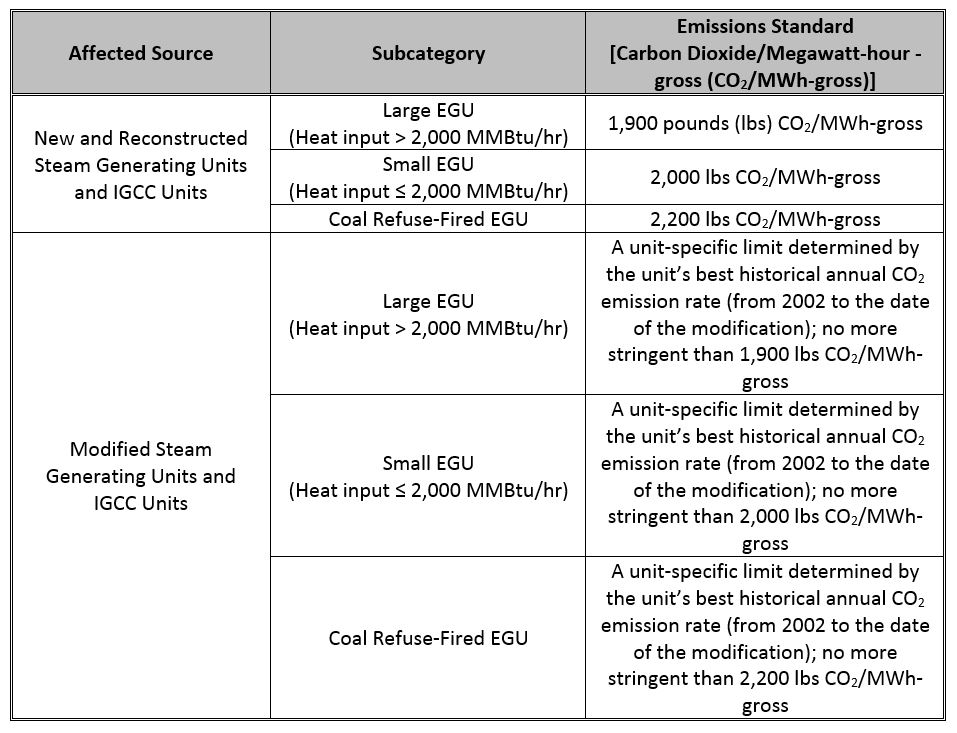Subpart TTTT: What to Know About Greenhouse Gas Emissions from Electric Utility Generating Units
Posted: March 27th, 2019
Authors: All4 Staff
With contribution from ALL4 Staff
On December 20, 2018, the U.S. Environmental Protection Agency proposed amendments to its “Standards of Performance for Greenhouse Gas (GHG) Emissions from New, Modified, and Reconstructed Stationary Sources: Electric Utility Generating Units (EGUs)” (i.e., 40 CFR Part 60 Subpart TTTT). Originally promulgated on October 23, 2015, Subpart TTTT was intended to limit the emissions of GHG from steam generating units, integrated gasification combined cycle units (IGCC), and stationary combustion turbines, collectively referred to within the rule as EGUs. In response to the March 28, 2017 Presidential Executive Order on Promoting Energy Independence and Economic Growth, U.S. EPA announced on April 2, 2017 that it was “reviewing, and if appropriate, will initiate proceedings to suspend, revise, or rescind” the rule.
U.S. EPA has completed its review, and is now proposing changes relating to the following:
- Rule applicability requirements.
- The Best System of Emissions Reduction (BSER) for newly constructed coal-fired steam generating units.
- The standards of performance for newly constructed steam generating units, reconstructed steam generating units, newly constructed and reconstructed coal refuse-fired EGUs, and large modifications of steam generating units.
- The establishment of three subcategories of steam generating units: large units, defined as units with heat input greater than 2,000 Million British Thermal Units (MMBtu)/hour (hr); small units, designated as units with heat input less than or equal to 2,000 MMBtu/hr; and units of any size (that meet the general Subpart TTTT applicability criteria) and that are fired with coal refuse.
- Miscellaneous technical changes in regulatory requirements.
It is noteworthy to mention that U.S. EPA is not proposing to amend and is not reopening the standards of performance for newly constructed or reconstructed stationary combustion turbines. Consistent with the October 2015 version of the rule, U.S. EPA is also not proposing standards of performance for stationary combustion turbines undergoing modification.
Let’s dig a little further into the amendments as currently proposed…
Proposed Revisions to Rule Applicability Requirements
U.S. EPA is proposing the following changes to the applicability criteria for combined heat and power (CHP) and non-fossil fuel-fired EGUs:
- To revise the definition of non-fossil EGU from EGUs capable of “combusting 50 percent or more non-fossil fuel-fired” to EGUs capable of “deriving 50 percent or more of the heat input from non-fossil fuel at the base load rating.”
- To revise the definition of “base load rating” to include the heat input from non-combustion sources (e.g., solar thermal).
- To allow alternative methods (as approved by the Administrator on a case-by-case basis) for determination of electric sales applicability as opposed to strictly using the design efficiency.
- To change the applicability of paragraph 40 CFR 60.8(b) from “no” to “yes” so that the Administrator can approve alternatives to the test methods specified in Subpart TTTT.
- To determine net electric sales for CHP units based upon the percentage of thermal power provided to the host facility by the specific CHP facility.
Proposed Revisions to BSER
U.S. EPA is proposing to relax what constitutes BSER for newly constructed or reconstructed EGUs. In the October 2015 version of the rule, partial carbon capture and storage (CCS) constitutes BSER for a newly constructed or reconstructed EGU. U.S. EPA is now proposing that BSER for a newly constructed or reconstructed EGU be operation of the EGU at the most efficient generating technology (i.e., the most efficient demonstrated steam cycle) in combination with best operating practices (BOPs).
What is the most efficient demonstrated steam cycle? Well, it depends on the size of the unit in question. For a “large EGU,” this would mean a system which uses steam under supercritical conditions. For a “small EGU,” or any coal refuse-fired EGU that meets Subpart TTTT applicability criteria, the most efficient demonstrated steam cycle would be a system which uses steam under best available subcritical conditions.
Proposed Revisions to Emissions Standards
U.S. EPA is proposing revision to the emissions standards of performance for newly constructed steam generating units, reconstructed steam generating units, and steam generating units undergoing modifications. Additionally, the proposal includes separate emissions standards for EGUs firing coal refuse. The proposed emissions standards are summarized in Table 1 below:
Table 1
Proposed Revisions to the EGU Standards of Performance

Closing
In this article we’ve shared an overview of the proposed amendments. For information concerning the Subpart TTTT proposal or how it might impact a project that is being considered, please contact our team at info@all4inc.com or 610-933-5246. ALL4 would be pleased to have a site-specific discussion with you concerning how the proposed amendments could impact your future projects.
